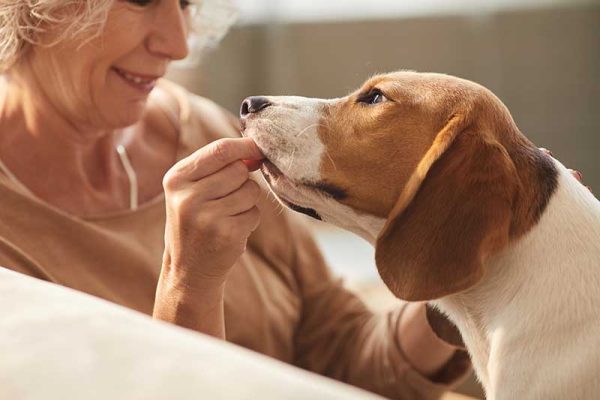As a pet parent, you worry about everything from getting your dog’s vaccines on time to how much you should be feeding him to keep him healthy and happy. Regarding feeding, there’s truly no clear-cut answer as to how much your pet needs to be fed.
The requirements, schedule, and how much depend on the size and breed of your dog. For example, you wouldn’t feed your miniature Poodle the same amount on the same schedule as you would your Great Dane. When determining a feeding schedule, you also need to factor in your own schedule and the individual dog’s preferences and needs.

How Often Should My Dog Be Fed?

It’s recommended that dogs be fed twice a day, splitting the recommended portions for the breed and size of your dog into two portions. However, this can change due to your dog’s feeding habits and your own schedule as well.
Some pet owners free-feed their pets; they put down one bowl of food once a day for their dog to eat. This lets the dog eat whenever they are hungry, and some pet parents prefer it when they can’t spend as much time at home. There are drawbacks to a free-feeding schedule, however.
You can’t monitor how much your dog eats when free feeding. It also makes it impossible to get your dog on a feeding schedule, which means your dog may have erratic bathroom breaks. Food that is allowed to sit out all day can attract insects and other creatures to your home as well, something no pet owner wants to have to deal with.
On the plus side, free feeding works well for dog breeds that will control their eating and only eat when they are hungry. Some dogs can’t and will eat until they make themselves sick. There are advantages to a free feeding schedule, but there are plenty of benefits to establishing a strict feeding schedule.

The 6 Reasons Why It’s Important to Put a Dog on a Feeding Schedule
Some veterinary experts and pet owners feel that it’s essential to put their canine pals on a strict feeding schedule.
1. Helps to Prevent Obesity
A feeding routine is especially important if you have a breed that is prone to obesity. Feeding the dog on a schedule helps you keep up with the number of calories it consumes each day. If the dog is allowed to free-feed instead, it’s possible that they are overeating, which can lead to weight gain, obesity, and health issues for your furry friend.
2. Helps with Bathroom Times

It stands to reason that if you don’t know when your dog has eaten, you can’t take them out for bathroom breaks at certain times. A feeding time is incredibly helpful when it comes to training a puppy. Most dogs will be ready to use the bathroom shortly after eating.
3. Allows More Variety in the Dog’s Diet
When it comes to free feeding your pet, you can only give the dog dry food since wet food can become rancid if left out long. Wet food also attracts insects, such as roaches and ants, more than dry food does. Putting your dog on a feeding schedule allows you to feed them a wider variety of foods, regardless of whether it’s wet or dry.
4. Helps You Keep a Cleaner House
Leaving food out can lead to pests invading your home, and the insects are not the only invaders you need to worry about. Mice and other rodents love eating dog food, and if you leave it outside all day on the porch or deck, they’ll eventually enter your home.
Putting your dog on a feeding schedule makes it easier to keep your home clean and safe for you, your family, and the pet you love.
5. Helps Your Dog Emotionally

If your dog deals with anxiety, having a set feeding schedule can relieve their stress. Set mealtimes not only helps the dog trust that you’ll feed them on time but also lets the dog know that you’re a good provider, which equates to less anxiety for your beloved pet.
6. Your Dog is a Creature of Habit
Dogs in the wild are often creatures of habit that prefer to eat at the same time every day if they can. Domestic dogs retain that desire and need. However, unlike a wild dog, your dog cannot go out and find food on their own; they’re completely dependent on you to feed them.

Conclusion
It’s recommended that you feed your dog twice a day at the same times every day; serving a meal as soon as it wakes up and one around dinnertime is ideal.
Some pet parents prefer free feeding their pets, and there’s nothing wrong with that if your dog has control of his eating habits, isn’t prone to obesity, and the food is in a secure area away from insects and rodents. If you’re unsure of the best way to feed your canine pal, consult your vet for feeding tips.
See Also:
- Why Does My Dog Eat So Fast? 5 Reasons & How to Help
- How to Make a Daily Dog Schedule: Creating the Perfect Routine for Your Pup
Featured Image Credit: Dmytro Zinkevych, Shutterstock


















